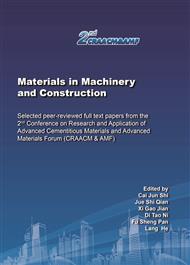[1]
E. Benhelal, G. Zahedi, E. Shamsaei, et al, Global strategies and potentials to curb CO2 emissions in cement industry, J. Clean. Prod. 51 (2013) 142–161.
DOI: 10.1016/j.jclepro.2012.10.049
Google Scholar
[2]
J.G. Jang, G.M. Kim, H.J. Kim, H.K. Lee, Review on recent advances in CO2 utilization and sequestration technologies in cement-based materials, Construction and Building Materials, Volume 127, 2016, Pages 762-773.
DOI: 10.1016/j.conbuildmat.2016.10.017
Google Scholar
[3]
P.J. Kong, G.H. Li, Application of diethanol-isopropanolamine as cement grinding aids, Proceedings of 2015 summit of cement grinding aids in China and annual meeting of cement grinding aids division, (2015)126-129.
DOI: 10.1680/adcr.13.00066
Google Scholar
[4]
X.L. Lu, S.X. Wang, C.H. Li, et al, Research on properties and the hydration of Portland limestone cement with diethanol-isopropanolamine, Ceram. Sili. 62 (2018)233-239.
DOI: 10.13168/cs.2018.0016
Google Scholar
[5]
M. Katsioti, P.E. Tsakiridis, P. Giannatos, et al, Characterization of various cement grinding aids and their impact on grindability and cement performance, Constr. Build. Mater. 23(2009)1954-1959.
DOI: 10.1016/j.conbuildmat.2008.09.003
Google Scholar
[6]
P. Somasundaran, S. Shrotri, Grinding aids: a review of their use, effect and mechanisms, Selected topics in mineral processing, Wiley Eastern Limited, 1995, p.47–70.
Google Scholar
[7]
Y. Shi, G.C. Long, J.H. He et al, Effect of triethanolamine on hydration process and strength of cement-fly ash system, B. Chin. Ceram. Soc. 39(2020)1077-1084.
Google Scholar
[8]
C.J. Shi, H. Liu, P.L. Li, Effects of triisopropanolamine on hydration and microstructure of Portland limestone cement, J. Chin. Ceram. Soc. 39(2011)1673-1681.
Google Scholar
[9]
Z.Q. Xu, W.F. Li, Y.Y. Hu, et al, Effect of alkanolamine on cement hydration process and performance, J. Chin. Ceram. Soc. 11(2016)1628-1635.
Google Scholar
[10]
V.H. Dodson, Concrete admixture, Van Nostrand Reinhold, New York, (1990).
Google Scholar
[11]
M. Ichikawa, M. Kanaya, S. Sano, Effect of triisopropanolamine on hydration and strength development of cements with different character, Proceedings of the 10th international congress on the chemistry of cement, Gothenburg, Sweden, 1997(Paper 3iii005).
Google Scholar
[12]
E. Gartner, D. Myers, Influence of tertiary alkanolamines on Portland-cement hydration, J. Am. Ceram. Soc. 76(1993)1521-1530.
DOI: 10.1111/j.1151-2916.1993.tb03934.x
Google Scholar
[13]
H. Huang, X.D. Shen, Hydration of ternary cement in the presence of triisopropanolamine. Constr. Build. Mater. 111(2016)513-521.
Google Scholar
[14]
C.J. Shi, H. Liu, P.L. Li, et al, Effects of triisopropanolamine on hydration and microstructure of Portland limestone cement, J. Chin. Ceram. Soc. 39(2011)1673-1681.
Google Scholar
[15]
H.F.W. Taylor, Cement Chemistry, 2nd Edition, Thomas Telford, London, (1997).
Google Scholar
[16]
K. Scrivener, R. Snellings, B. Lothenbach, A Practical Guide to Microstructural Analysis of Cementitious Materials, Taylor & Francis, New York, (2016).
DOI: 10.1201/b19074
Google Scholar
[17]
S. Jochen, Recent advances in the field of cement hydration and microstructure analysis, Cem. Concr. Res. 41(2011)666-678.
Google Scholar
[18]
K. Lyu, W. She, C.W. Miao, et al, Quantitative characterization of pore morphology in hardened cement paste via SEM-BSE image analysis, Constr. Build. Mater. 202(2019)589-602.
DOI: 10.1016/j.conbuildmat.2019.01.055
Google Scholar
[19]
J. Cheung, A. Jeknavorian, L. Roberts, et al, Impact of admixtures on the hydration kinetics of Portland cement, Cem. Concr. Res. 41(2011)1289-1309.
DOI: 10.1016/j.cemconres.2011.03.005
Google Scholar
[20]
A. Quennoz, K.L. Scrivener, Hydration of C3A-gypsum systems, Cem. Concr. Res. 42(2012)1032-1041.
DOI: 10.1016/j.cemconres.2012.04.005
Google Scholar
[21]
I.G. Richardson, The nature of C-S-H in hardened cements, Cem. Concr. Res. 29(1999)1131-1147.
Google Scholar
[22]
P.M. Zhan, Z.H. He, Application of shrinkage reducing admixture in concrete: A review, Constr. Build. Mater. 201(2019)676-690.
DOI: 10.1016/j.conbuildmat.2018.12.209
Google Scholar
[23]
X.J. Zhang, G.Z. Zhang, D.S. Sun, et al, Progress of the mechanism of sulfate attack on cement-based material, Mater. Rev. 32(2018)1174-1180.
Google Scholar
[24]
B.Z. Dilnesa, E. Wieland, B. Lothenbach, et al, Fe-containing phases in hydrated cements. Cem. Concr. Res. 58(2014)45-55.
DOI: 10.1016/j.cemconres.2013.12.012
Google Scholar


